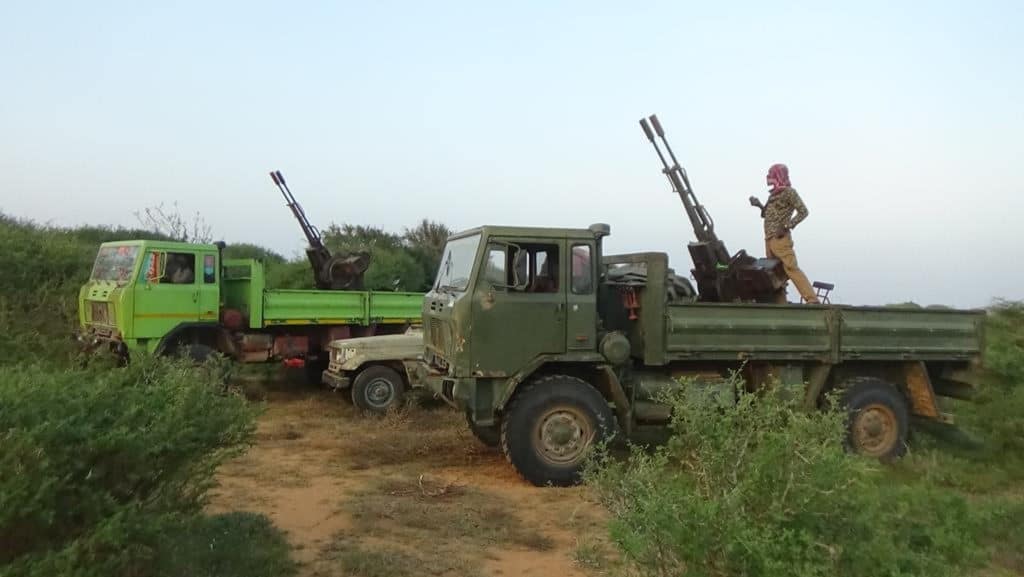
In a large assault yesterday, Shabaab, al Qaeda’s branch in East Africa, raided a Somali military base in the town of Bacaadweyne in the central Mudug Region.
According to local media reports, Shabaab militants clashed with Somali troops from the federal army’s 21st Division before moving into the adjacent town and briefly occupying it.
Photos released by Shabaab today appear to corroborate the local reporting. The pictures show the jihadists moving into the base, capturing several vehicles and various weapons. Other photos then show the fighters walking around central Bacaadweyne unopposed.
The pictures do not show any actual fighting, however, several dead Somali troops are shown inside the base.
Voice of America’s Somali service added that the town was later recaptured by government forces after armed citizens joined in a counter-offensive against the jihadists.
Casualty figures from yesterday’s fighting has varied widely. Voice of America reported that four Somali soldiers and 10 civilians involved in the counter-offensive were killed.
Meanwhile, Mudug officials claimed that 12 members of Shabaab were killed. Other sources have indicated that at least 20 people were killed in total.
For its part, Shabaab said it killed 53 soldiers and militiamen. In response, Somali military officials stated that their forces killed 50 jihadists in the fighting. An additional 6 militants were reportedly captured.
Despite the discrepancies in casualty numbers, it is clear that Shabaab did in fact overrun the military base and town albeit only briefly. While most of its resources are invested in southern Somalia, the al Qaeda branch has shown it remains a potent threat across much of the country.
Recent String of Attacks
The raid in Bacaadweyne comes after a series of other recent Shabaab attacks across Somalia.
Just before the Bacaadweyne raid yesterday, Shabaab was also responsible for an attack on the Turkish-trained Gorgor special forces unit in Lower Shabelle. That ambush occurred as Somali troops mounted an operation near Afgooye on the outskirts of Mogadishu.
On Sunday, the jihadist group was also blamed for murdering an entire family in the southern Bakool Region. Shabaab did not comment on this series of purported executions.
While on Nov. 27, a Shabaab suicide bomber detonated himself outside an ice cream parlor in Mogadishu killing at least 7 people.
In its claim of responsibility, Shabaab said it was targeting a grouping of government officials. However, most reporting indicates the victims were civilians.
On Nov. 24, 6 Somali soldiers from the US-trained Danab special forces unit were purportedly killed in an IED in the southern Lower Shabelle Region not far from the joint Somali-US base at Baledogle.
A few days earlier on Nov. 17, Shabaab conducted another suicide bombing at a restaurant in Mogadishu which killed 5 civilians.
And finally, on Nov. 6, Shabaab claimed it killed an American soldier in suicide bombing during a failed raid on the jihadists in the coastal city of Gandershe.
The United States has not commented on this claim, but on Nov. 26, the Central Intelligence Agency did admit one of its officers was recently killed in Somalia. It is possible that the officer was killed in the alleged Nov. 6 raid.
With these recent attacks, Shabaab has conducted at least 29 suicide bombings inside Somalia since the beginning of 2020 according to data compiled by FDD’s Long War Journal.
Despite some setbacks in recent years, Shabaab continues to be one of al Qaeda’s most effective branches. It maintains significant control over much of southern Somalia and retains the ability to strike in Mogadishu, Kenya, and against heavily fortified bases in both Somalia and Kenya.
Though its fortunes have ebbed and flowed over the past decade, it has weathered numerous offensives from an array of local, regional, and international actors, including the United States.
Photos released by Shabaab reportedly from the raid in Bacaadweyne:













